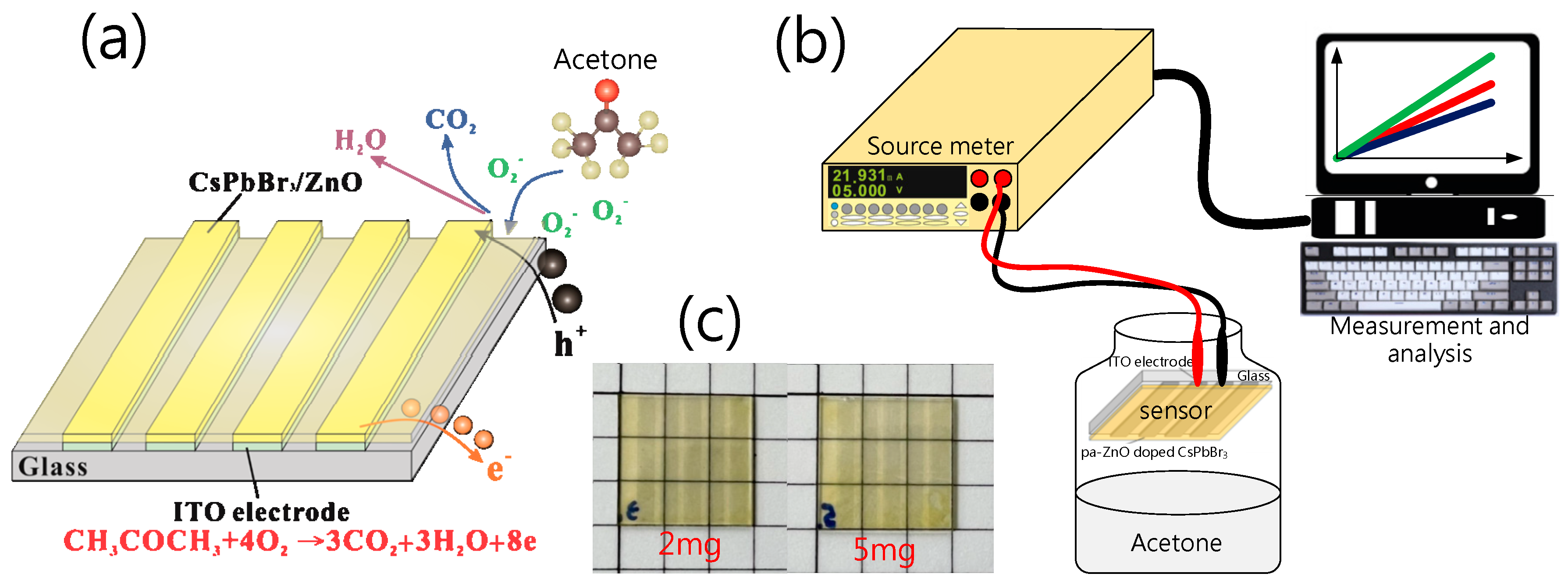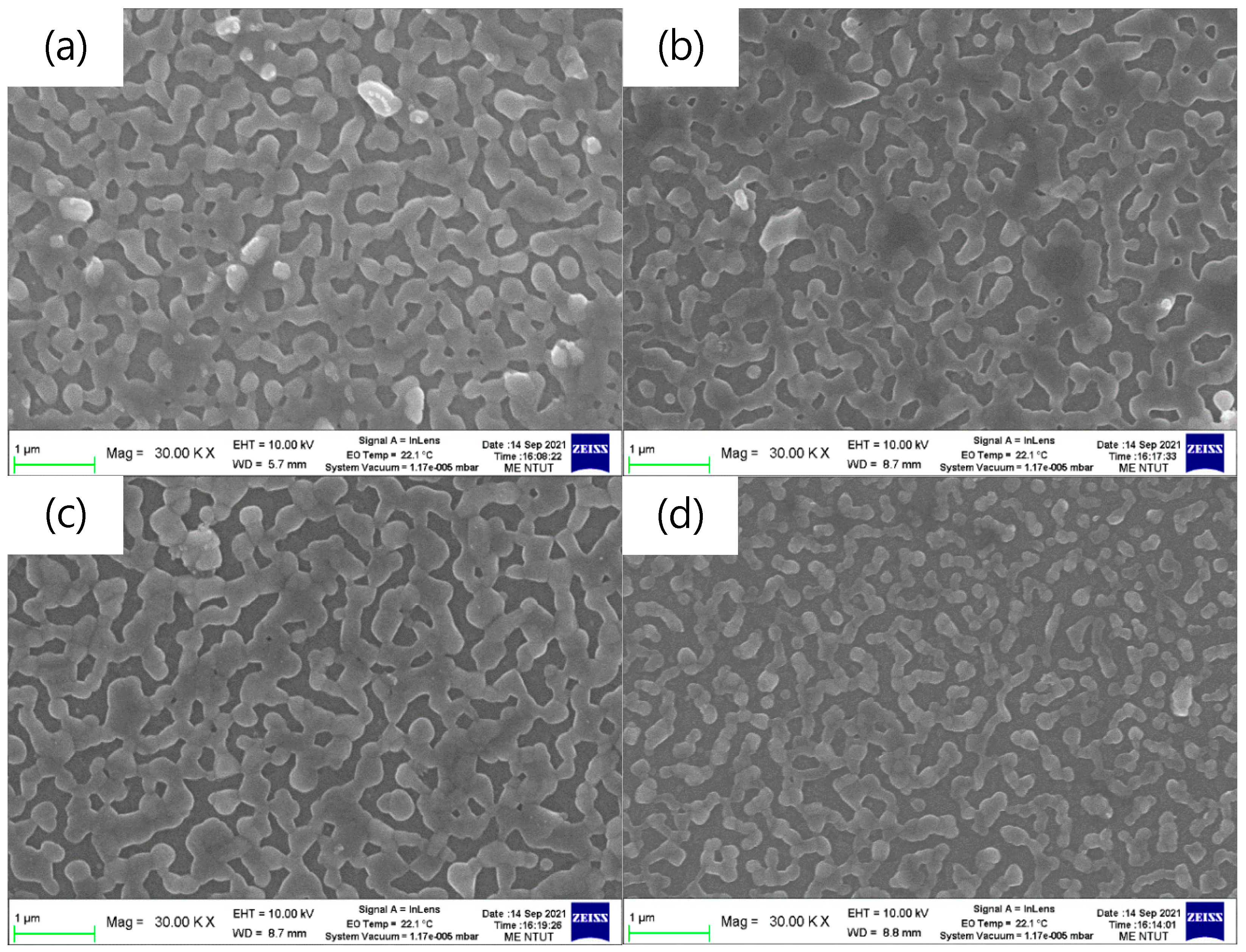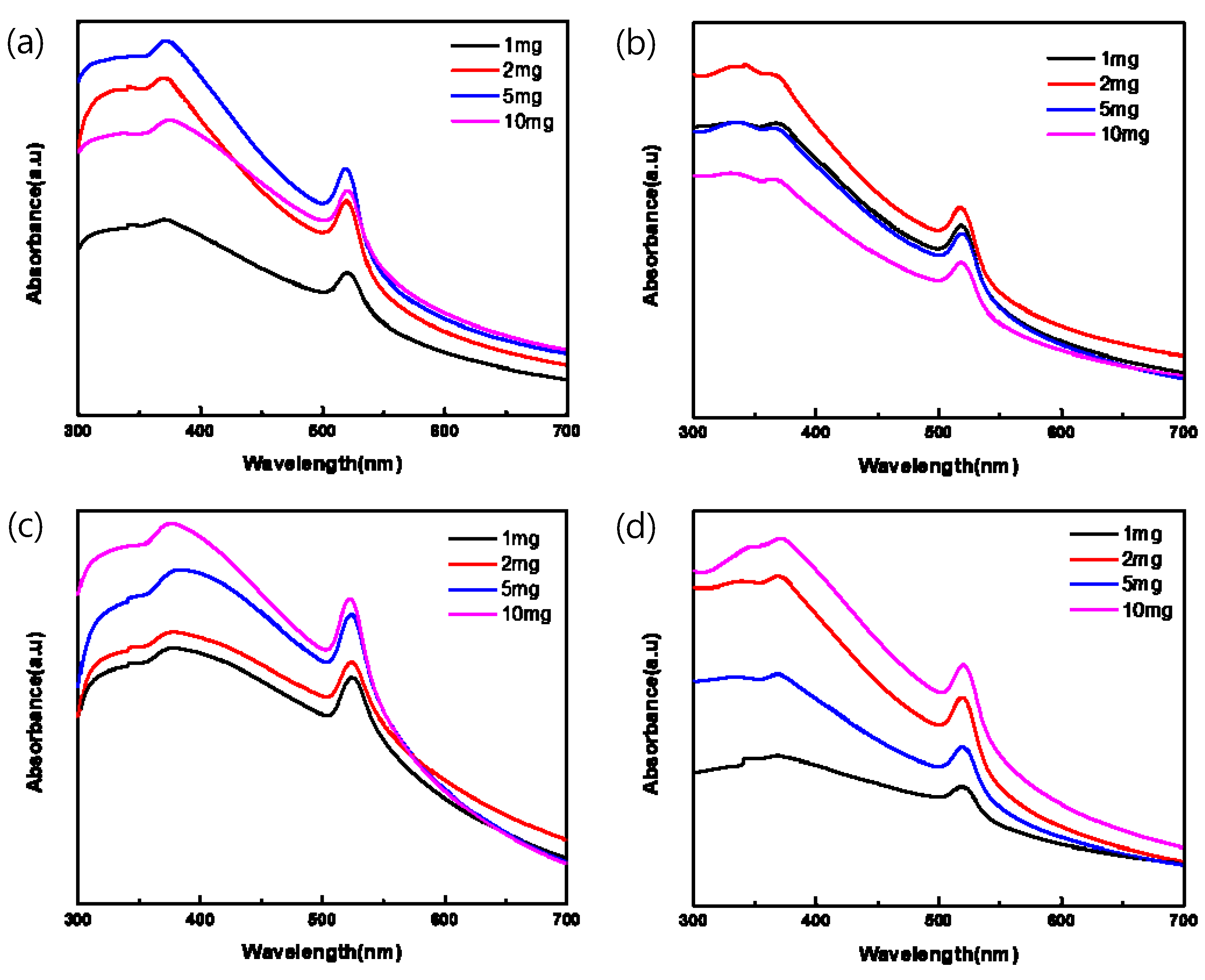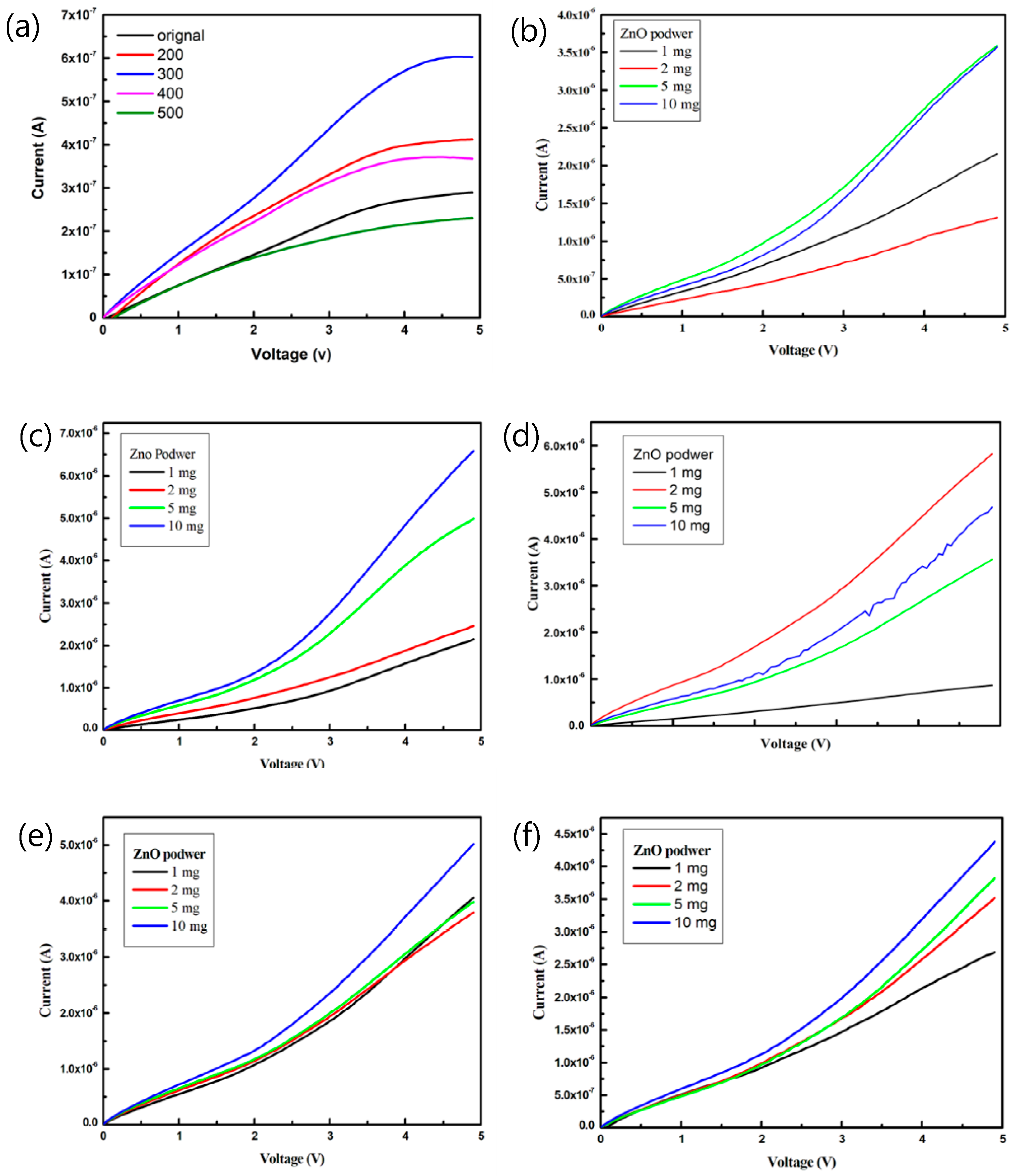A Study of High-Sensitivity Electro-Resistance Type Pre-Annealing ZnO-Doped CsPbBr3 Perovskite Acetone Sensors
Abstract
:1. Introduction
2. Materials and Methods
3. Results and Discussion
4. Conclusions
Author Contributions
Funding
Institutional Review Board Statement
Informed Consent Statement
Data Availability Statement
Conflicts of Interest
References
- Amor, R.E.; Nakhleh, M.K.; Barash, O.; Haick, H. Breath analysis of cancer in the present and the future. Eur. Respir. Rev. 2019, 28, 190002. [Google Scholar] [CrossRef] [PubMed]
- Hakim, M.; Broza, Y.Y.; Barash, O.; Peled, N.; Phillips, M.; Amann, A.; Haick, H. Volatile organic compounds of lung cancer and possible biochemical pathways. Chem. Rev. 2012, 112, 5949–5966. [Google Scholar] [CrossRef] [PubMed]
- Huang, C.Y.; Wu, C.C.; Wu, C.L.; Lin, C.W. CsPbBr3 Perovskite Powder, a Robust and Mass-Producible Single-Source Precursor: Synthesis, Characterization, and Optoelectronic Applications. ACS Omega 2019, 4, 8081–8086. [Google Scholar] [CrossRef] [PubMed]
- Amiri, V.; Roshan, H.; Mirzaei, A.; Neri, G.; Ayesh, A.I. Nanostructured Metal Oxide-Based Acetone Gas Sensors: A Review. Sensors 2020, 20, 3096. [Google Scholar] [CrossRef]
- Liu, J.; Liu, F.J.; Liu, H.N.; Yue, J.Y.; Jin, J.Y.; Impundu, J.; Liu, H.; Yang, Z.; Peng, Z.S.; Wei, H.N.; et al. Mixed-dimensional CsPbBr3@ZnO heterostructures for high-performance p-n diodes and photodetectors. Nano Today 2021, 36, 101055. [Google Scholar] [CrossRef]
- Neogi, S.; Ghosh, R. Ion-dipole interaction for selective detection of acetone by perovskite BiFeO3 chemi-resistive sensor. Anal. Chim. Acta 2022, 1206, 339788. [Google Scholar] [CrossRef]
- Solanki, V.; Banerjee, A.; Nanda, K.K. Conductometric room temperature ammonia sensor based on porous tin oxide. Sens. Actuators B-Chem. 2022, 366, 131942. [Google Scholar] [CrossRef]
- Wongrat, E.; Chanlek, N.; Chueaiarrom, C.; Thupthimchun, W.; Samransuksamer, B.; Choopun, S. Acetone gas sensors based on ZnO nanostructures decorated with Pt and Nb. Ceram. Int. 2017, 43, S557–S566. [Google Scholar] [CrossRef]
- Schanze, K.S.; Kamat, P.V.; Yang, P.; Bisquert, J. Progress in perovskite photocatalysis. ACS Energy Lett. 2020, 5, 2602–2604. [Google Scholar] [CrossRef]
- Kojima, A.; Teshima, K.; Shirai, Y.; Miyasaka, T. Organometal halide perovskites as visible-light sensitizers for photovoltaic cells. J. Am. Chem. Soc. 2009, 131, 6050–6051. [Google Scholar] [CrossRef]
- Liu, Z.; Krückemeier, L.; Krogmeier, B.; Klingebiel, B.; Márquez, J.; Levcenko, S.; Öz, S.; Mathur, S.; Rau, U.; Unold, T.; et al. Open-circuit voltages exceeding 1.26 V in planar methylammonium lead iodide perovskite solar cells. ACS Energy Lett. 2019, 4, 110–117. [Google Scholar] [CrossRef]
- Gao, B.; Meng, J.; Lu, J.; Zhao, R. CH3NH3PbI3 perovskite solar cells with efficiency over 22% fabricated by green antisolvent method. Mater. Lett. 2020, 274, 127995. [Google Scholar] [CrossRef]
- Park, J.; Jang, H.M.; Kim, S.; Jo, S.H.; Lee, T.W. Electroluminescence of Perovskite Nanocrystals with Ligand Engineering. Trends Chem. 2020, 2, 837–849. [Google Scholar] [CrossRef]
- He, Q.; Mei, E.; Liang, X.; Xiang, W. Ultrastable PVB films-protected CsPbBr3/Cs4PbBr6 perovskites with high color purity for nearing Rec. 2020 standard. Chem. Eng. J. 2021, 419, 129529. [Google Scholar] [CrossRef]
- Ahmad, S.; Husain, A.; Khan, M.M.A.; Khan, I.; Khan, A.; Asiri, A.M. Perovskite-based material for sensor applications. Hybrid Perovskite Compos. Mater. 2021, 135–145. [Google Scholar]
- Fergus, J.W. Perovskite oxides for semiconductor-based gas sensors. Sens. Actuators B Chem. 2007, 123, 1169–1179. [Google Scholar] [CrossRef]
- Hu, L.; Shao, G.; Jiang, T.; Li, D.; Lv, X.; Wang, H.; Liu, X.; Song, H.; Tang, J.; Liu, H. Investigation of the Interaction between Perovskite Films with Moisture via in Situ Electrical Resistance Measurement. ACS Appl. Mater. Interface 2015, 7, 25113–25120. [Google Scholar] [CrossRef]
- Zhao, M.; Shi, Y.; Dai, J.; Lian, J. Ellipsometric study of the complex optical constants of a CsPbBr3 perovskite thin film. J. Mater. Chem. C 2018, 6, 10450–10455. [Google Scholar] [CrossRef]
- Zhang, L.; Zhang, Y.; He, W.; Peng, H.; Dai, Q. CsPbBr3 perovskite nanowires and their optical properties. Opt. Mater. 2020, 109, 110399. [Google Scholar] [CrossRef]
- Chen, L.C.; Kao, C.H. Improved extraction efficiency of CsPbBr3 perovskite light-emitting diodes due to anodic aluminum oxide nanopore structure. Sci. Rep. 2022, 12, 14750. [Google Scholar] [CrossRef] [PubMed]
- Yoo, R.; Güntner, A.T.; Park, Y.; Rim, H.J.; Lee, H.S.; Lee, W. Sensing of acetone by Al-doped ZnO. Sens. Actuators B Chem. 2019, 283, 107–115. [Google Scholar] [CrossRef]
- Yen, M.C.; Lee, C.J.; Liu, K.H.; Peng, Y.; Leng, J.; Chang, T.H.; Chang, C.C.; Tamada, K.; Lee, Y.J. All-inorganic perovskite quantum dot light-emitting memories. Nat. Commun. 2021, 12, 4460. [Google Scholar] [CrossRef] [PubMed]
- Zhang, X.; Wang, H.C.; Tang, A.C.; Lin, S.Y.; Tong, H.C.; Chen, C.Y.; Lee, Y.C.; Tsai, T.L.; Liu, R.S. Robust and Stable Narrow-Band Green Emitter: An Option for Advanced Wide-Color-Gamut Backlight Display. Chem. Mater. 2016, 28, 8493–8497. [Google Scholar] [CrossRef]
- Shen, H.; Nan, R.; Jian, Z.; Li, X. Defect step controlled growth of perovskite MAPbBr3 single crystal. J. Mater. Sci. 2019, 54, 11596–11603. [Google Scholar] [CrossRef]
- Yuan, B.; Li, N.; Liu, J.; Xu, F.; Li, C.; Juan, F.; Yu, H.; Li, C.; Cao, B. Improving the performances of CsPbBr3 solar cells fabricated in ambient condition. J. Mater. Sci. 2020, 31, 21154–21167. [Google Scholar] [CrossRef]
- Son, D.; Moon, B.J.; Lee, A.; Rho, H.; Lee, H.J.; Kim, T.W.; Ha, J.S.; Lee, S.H. Polarity effects of ZnO on charge recombination at CsPbBr3 nanoparticles/ZnO interfaces. App. Sur. Sci. 2019, 483, 165–169. [Google Scholar] [CrossRef]
- Tien, C.H.; Lee, K.L.; Tao, C.C.; Lin, Z.Q.; Lin, Z.H.; Chen, L.C. Two-Dimensional (PEA)2PbBr4 Perovskites Sensors for Highly Sensitive Ethanol Vapor Detection. Sensors 2022, 22, 8155. [Google Scholar] [CrossRef] [PubMed]
- Alizadeh, N.; Jamalabadi, H.; Tavoli, F. Breath Acetone Sensors as Non-Invasive Health Monitoring Systems: A Review. IEEE Sens. J. 2020, 20, 5–31. [Google Scholar] [CrossRef]
- Shokrekhodaei, M.; Quinones, S. Review of Non-Invasive Glucose Sensing Techniques: Optical, Electrical and Breath Acetone. Sensors 2020, 20, 1251. [Google Scholar] [CrossRef] [PubMed]
- Shellaiah, M.; Sun, K.W. Review on Sensing Applications of Perovskite Nanomaterials. Chemosensors 2020, 8, 55. [Google Scholar] [CrossRef]
- Verma, A.; Yadav, D.; Singh, A.; Gupta, M.; Thapa, K.B.; Yadav, B.C. Detection of acetone via exhaling human breath for regular monitoring of diabetes by low-cost sensing device based on perovskite BaSnO3 nanorods. Sens. Actuators B Chem. 2022, 361, 131708. [Google Scholar] [CrossRef]







| pa-ZnO Doping | w/o Annealing | 200 °C | 300 °C | 400 °C | 500 °C |
|---|---|---|---|---|---|
| 1 mg | 75 | 134 | 248 | 143 | 288 |
| 2 mg | 351 | 755 | 1726 | 349 | 463 |
| 5 mg | 512 | 951 | 1542 | 1250 | 430 |
| 10 mg | 484 | 885 | 1158 | 1599 | 791 |
Disclaimer/Publisher’s Note: The statements, opinions and data contained in all publications are solely those of the individual author(s) and contributor(s) and not of MDPI and/or the editor(s). MDPI and/or the editor(s) disclaim responsibility for any injury to people or property resulting from any ideas, methods, instructions or products referred to in the content. |
© 2023 by the authors. Licensee MDPI, Basel, Switzerland. This article is an open access article distributed under the terms and conditions of the Creative Commons Attribution (CC BY) license (https://creativecommons.org/licenses/by/4.0/).
Share and Cite
Chen, L.-C.; Sung, A.-N.; Lee, K.-Y. A Study of High-Sensitivity Electro-Resistance Type Pre-Annealing ZnO-Doped CsPbBr3 Perovskite Acetone Sensors. Sensors 2023, 23, 2164. https://doi.org/10.3390/s23042164
Chen L-C, Sung A-N, Lee K-Y. A Study of High-Sensitivity Electro-Resistance Type Pre-Annealing ZnO-Doped CsPbBr3 Perovskite Acetone Sensors. Sensors. 2023; 23(4):2164. https://doi.org/10.3390/s23042164
Chicago/Turabian StyleChen, Lung-Chien, An-Ni Sung, and Kun-Yi Lee. 2023. "A Study of High-Sensitivity Electro-Resistance Type Pre-Annealing ZnO-Doped CsPbBr3 Perovskite Acetone Sensors" Sensors 23, no. 4: 2164. https://doi.org/10.3390/s23042164






